Cladistic analysis of olfactory and vomeronasal systems
- PMID: 21290004
- PMCID: PMC3032080
- DOI: 10.3389/fnana.2011.00003
Cladistic analysis of olfactory and vomeronasal systems
Abstract
Most tetrapods possess two nasal organs for detecting chemicals in their environment, which are the sensory detectors of the olfactory and vomeronasal systems. The seventies' view that the olfactory system was only devoted to sense volatiles, whereas the vomeronasal system was exclusively specialized for pheromone detection was challenged by accumulating data showing deep anatomical and functional interrelationships between both systems. In addition, the assumption that the vomeronasal system appeared as an adaptation to terrestrial life is being questioned as well. The aim of the present work is to use a comparative strategy to gain insight in our understanding of the evolution of chemical "cortex." We have analyzed the organization of the olfactory and vomeronasal cortices of reptiles, marsupials, and placental mammals and we have compared our findings with data from other taxa in order to better understand the evolutionary history of the nasal sensory systems in vertebrates. The olfactory and vomeronsasal cortices have been re-investigated in garter snakes (Thamnophis sirtalis), short-tailed opossums (Monodelphis domestica), and rats (Rattus norvegicus) by tracing the efferents of the main and accessory olfactory bulbs using injections of neuroanatomical anterograde tracers (dextran-amines). In snakes, the medial olfactory tract is quite evident, whereas the main vomeronasal-recipient structure, the nucleus sphaericus is a folded cortical-like structure, located at the caudal edge of the amygdala. In marsupials, which are acallosal mammals, the rhinal fissure is relatively dorsal and the olfactory and vomeronasal cortices relatively expanded. Placental mammals, like marsupials, show partially overlapping olfactory and vomeronasal projections in the rostral basal telencephalon. These data raise the interesting question of how the telencephalon has been re-organized in different groups according to the biological relevance of chemical senses.
Keywords: amygdala; cortex; evolution; olfaction; olfactory bulb; vomeronasal.
Figures
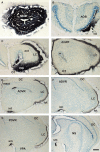
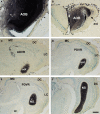

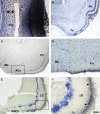
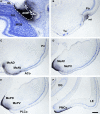

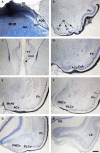
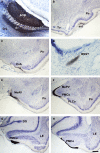


Similar articles
-
Centrifugal telencephalic afferent connections to the main and accessory olfactory bulbs.Front Neuroanat. 2012 May 29;6:19. doi: 10.3389/fnana.2012.00019. eCollection 2012. Front Neuroanat. 2012. PMID: 22661931 Free PMC article.
-
Efferent connections of the main olfactory bulb in the opossum (Monodelphis domestica): a characterization of the olfactory entorhinal cortex in a marsupial.Neurosci Lett. 2006 Feb 27;395(1):51-6. doi: 10.1016/j.neulet.2005.10.052. Epub 2005 Nov 17. Neurosci Lett. 2006. PMID: 16298058
-
Convergence of olfactory and vomeronasal projections in the rat basal telencephalon.J Comp Neurol. 2007 Oct 1;504(4):346-62. doi: 10.1002/cne.21455. J Comp Neurol. 2007. PMID: 17663431
-
Sex pheromone systems in goldfish: comparisons to vomeronasal systems in tetrapods.Brain Behav Evol. 1993;42(4-5):265-80. doi: 10.1159/000114166. Brain Behav Evol. 1993. PMID: 8252378 Review.
-
On the organization of olfactory and vomeronasal cortices.Prog Neurobiol. 2009 Jan 12;87(1):21-30. doi: 10.1016/j.pneurobio.2008.09.010. Epub 2008 Sep 25. Prog Neurobiol. 2009. PMID: 18929620 Review.
Cited by
-
Synchrotron microtomography of a Nothosaurus marchicus skull informs on nothosaurian physiology and neurosensory adaptations in early Sauropterygia.PLoS One. 2018 Jan 3;13(1):e0188509. doi: 10.1371/journal.pone.0188509. eCollection 2018. PLoS One. 2018. PMID: 29298295 Free PMC article.
-
Histochemical and ultrastructural analyses of the lubrication systems in the olfactory organs of soft-shelled turtle.J Vet Med Sci. 2016 Jun 1;78(5):769-74. doi: 10.1292/jvms.15-0564. Epub 2016 Jan 18. J Vet Med Sci. 2016. PMID: 26782135 Free PMC article.
-
Mutual influences between the main olfactory and vomeronasal systems in development and evolution.Front Neuroanat. 2012 Dec 24;6:50. doi: 10.3389/fnana.2012.00050. eCollection 2012. Front Neuroanat. 2012. PMID: 23269914 Free PMC article.
-
The human olfactory system in two proteinopathies: Alzheimer's and Parkinson's diseases.Transl Neurodegener. 2020 Jun 3;9(1):22. doi: 10.1186/s40035-020-00200-7. Transl Neurodegener. 2020. PMID: 32493457 Free PMC article. Review.
-
Immunohistochemical analysis for G protein in the olfactory organs of soft-shelled turtle, Pelodiscus sinensis.J Vet Med Sci. 2016 Feb;78(2):245-50. doi: 10.1292/jvms.15-0359. Epub 2015 Oct 5. J Vet Med Sci. 2016. PMID: 26440778 Free PMC article.
References
-
- Abellan A., Legaz I., Vernier B., Retaux S., Medina L. (2009). Olfactory and amygdalar structures of the chicken ventral pallium based on the combinatorial expression patterns of LIM and other developmental regulatory genes. Comp. J. Neurol. 516, 166–186 - PubMed
-
- Alonso J. R., Covenas R., Lara J., Arevalo R., de Leon M., Aijon J. (1989). Tyrosine hydroxylase immunoreactivity in a subpopulation of granule cells in the olfactory bulb of teleost fish. Brain Behav. Evol. 34, 318–324 - PubMed
LinkOut - more resources
Full Text Sources

